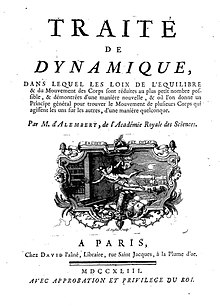
Back مبدأ دالمبير Arabic Principi de d'Alembert Catalan D'Alembertův princip Czech D’Alembertsches Prinzip German Principio de d'Alembert Spanish اصل دالامبر Persian Principe de d'Alembert French עקרון ד'אלמבר HE दालाँवेयर का सिद्धान्त Hindi D’Alembert-elv Hungarian

| Part of a series on |
| Classical mechanics |
|---|

D'Alembert's principle, also known as the Lagrange–d'Alembert principle, is a statement of the fundamental classical laws of motion. It is named after its discoverer, the French physicist and mathematician Jean le Rond d'Alembert, and Italian-French mathematician Joseph Louis Lagrange. D'Alembert's principle generalizes the principle of virtual work from static to dynamical systems by introducing forces of inertia which, when added to the applied forces in a system, result in dynamic equilibrium.[1][2]
D'Alembert's principle can be applied in cases of kinematic constraints that depend on velocities.[1]: 92 The principle does not apply for irreversible displacements, such as sliding friction, and more general specification of the irreversibility is required.[3][4]
- ^ a b Lanczos, Cornelius (1964). Variational principles of mechanics. Toronto, University of Toronto Press. p. 92.
- ^ d'Alembert, Jean le Rond (1743). Traité de dynamique. pp. 50–51.
- ^ Udwadia, F. E.; Kalaba, R. E. (2002). "On the Foundations of Analytical Dynamics" (PDF). Intl. Journ. Nonlinear Mechanics. 37 (6): 1079–1090. Bibcode:2002IJNLM..37.1079U. CiteSeerX 10.1.1.174.5726. doi:10.1016/S0020-7462(01)00033-6. Archived from the original (PDF) on 2010-06-13.
- ^ Gay-Balmaz, François; Yoshimura, Hiroaki (2018). "From Lagrangian Mechanics to Nonequilibrium Thermodynamics: A Variational Perspective". Entropy. 21 (1): 8. arXiv:1904.03738. Bibcode:2018Entrp..21....8G. doi:10.3390/e21010008. ISSN 1099-4300. PMC 7514189. PMID 33266724.
